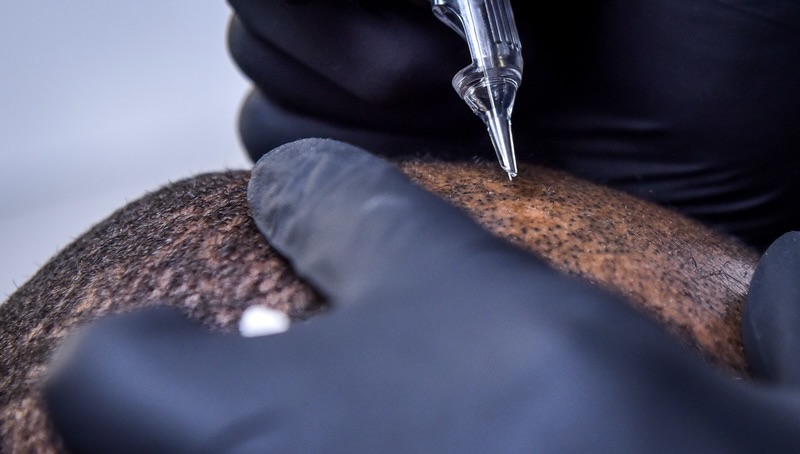Scalp micro-pigmentation is a form of camouflage for the scalp done by creating dotted scalp tattoos in the affected bald area. This dotted effect results in the scalp having a ‘stubble’ hair look and can mask bald patches giving the illusion of very short hair.
In scalp micro-pigmentation (SMP), a micro droplet of pigment is inserted through the skin and into the upper dermis using a standard tattoo instrument. For some, this kind of art is not aesthetically pleasing and therefore not accepted routinely by medical practitioners.
The medical and surgical conditions that can be addressed by scalp micro-pigmentation are:
1)- Covering scalp scars caused by scarring alopecia
2)- Non-scarring alopecia cause by immune disorder, mainly alopecia totalis.
3)- Women with female pattern alopecia irresponsive to minoxidil and where hair transplantation is not appropriate.
4)- Scalp scars from trauma surgery or hair follicle extraction scars.
5)- Chemotherapy patients who do not grow their hair back.
6)- failed hair transplant surgeries
7)- Patients who have had a wide strip of donor hair region at the back of scalp that needs covering.
8)- Patients who have had older unit follicular extraction scars.
For a perfect dot of scalp tattoo to form, there are various factors that are important. The mathematical relationship between an ideal dot of ink injected into the scalp can be summed up by the equation:
Ideal pigment deposit = § [ (A) x (D) x (T) / (R) ] x C x V
Where A= Angle of needle against the scalp, D= Depth of needle into the scalp, T= Time the needle is left in the scalp, R= Resistance of the scalp (is an intrinsic factor that varies locally in the scalp of the individual), C= Colour of pigment, V= viscosity of pigment, N= Needle size, type, number, cycling speeds, §= the approximate mathematical relationship between the variables.
The pigment has to be inserted high up in the dermis. If inserted in the epidermis, the tattoo will ‘leak’ into the surrounding area giving an irregular look. The who process of SMP can take 2 to 4 sessions.
There may be a blue/green tinge to the pigment under the skin and this may further change in time due to exposure to UV light. Also, as the ink pigment is in the dermis, it is not initially stable due to the body’s immune reaction and some pigments may be absorbed or change in colour over time.
Risks and complications of the procedure include: infections, allergies to the components of the ink, magnetic resonance imaging (MRI) complications such as swelling and pain from the metals in the pigments when exposed to MRI magnetic fields. One should be extremely careful in using scalp micro-pigmentation in active scarring alopecia as there can be a risk of immune response, to the inks and procedure making the scarring alopecia worse.
To get micro-pigmentation right, it is therefore important to go to a qualified practitioner specialising in this.

